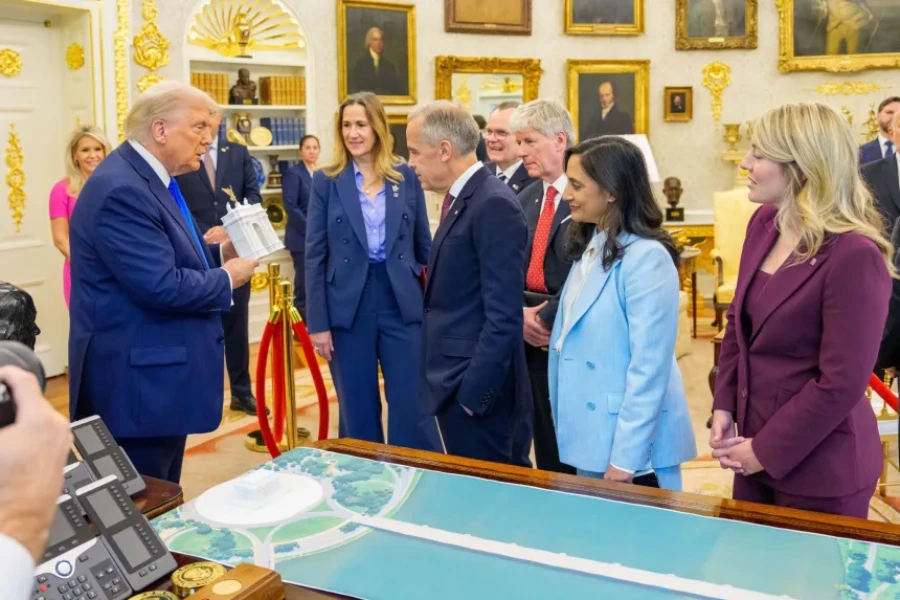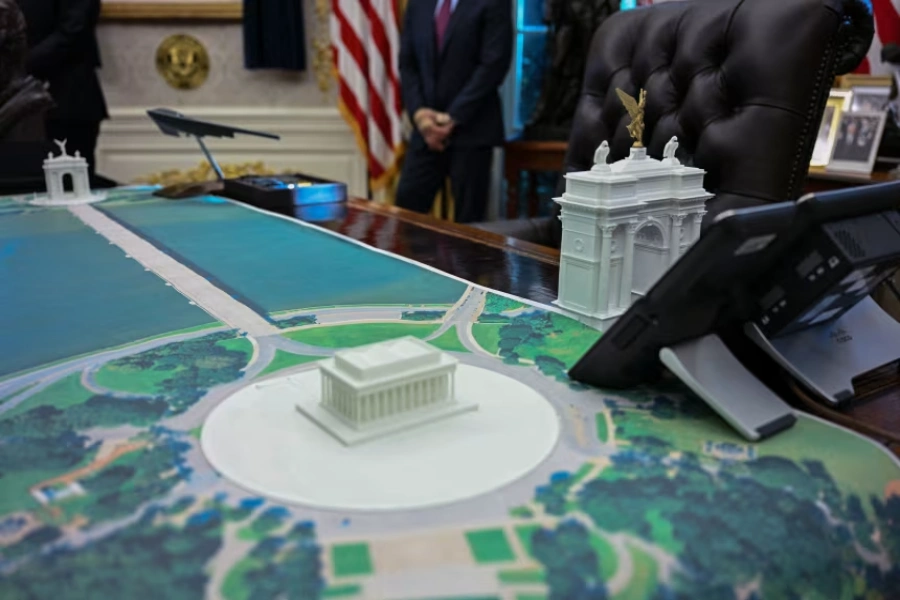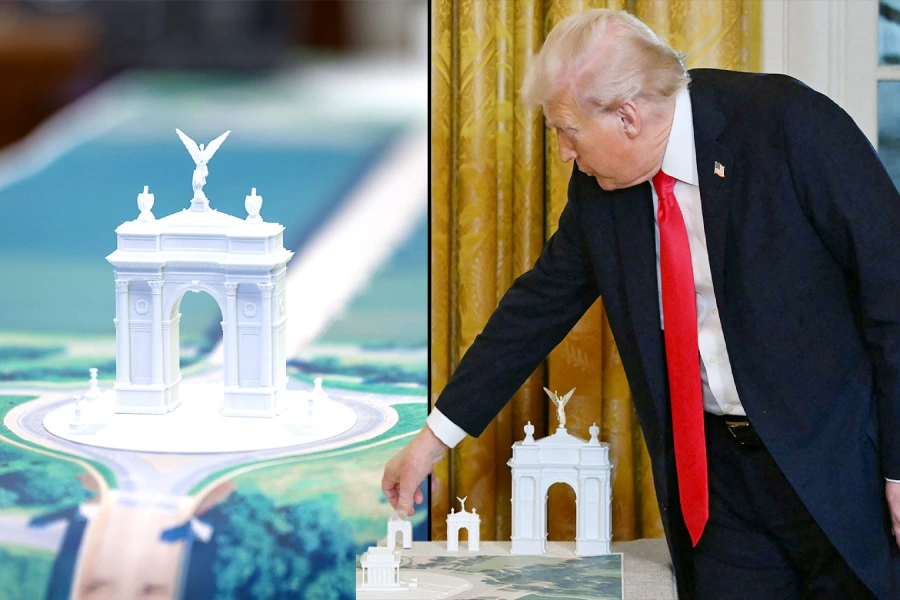The proposed Arc de Trump, a massive stone monument envisioned by President Donald Trump to commemorate America’s 250th anniversary, is drawing attention not only for its grandeur but also for the complex legal framework that governs such projects on federal land. Positioned to stand near the Arlington Memorial Bridge, the structure could redefine Washington’s skyline—if it survives a maze of constitutional, regulatory, and ethical scrutiny.

Arc de Trump: A Presidential Monument or Public Project?
According to multiple reports from USA Today, CNN, and The Telegraph, Trump unveiled his concept for the Arc de Trump during a private donor event at the White House. The model—displayed alongside plans for a $250 million White House ballroom—shows a triumphal arch reminiscent of Paris’s Arc de Triomphe, adorned with eagles, wreaths, and a winged figure of liberty.
Trump described the arch as a “gateway to Washington,” intended to stand between Arlington National Cemetery and the Lincoln Memorial. He told attendees, “It’s going to be exquisite. Real estate relaxes me.”
Yet beneath the architectural ambition lies a fundamental question: Does the president have the authority to build a personal monument on federal property?
Legal Framework Governing the Arc de Trump
Constructing any permanent monument in the capital involves a web of laws and oversight bodies. The Arc de Trump would likely fall under the jurisdiction of the following:
-
The Commemorative Works Act (40 U.S.C. Chapter 89) – Governs the establishment of monuments on federal land within Washington, D.C., ensuring that new works meet historical, artistic, and public significance criteria.
-
The National Capital Planning Commission (NCPC) – Responsible for land-use approvals in federal areas of the capital.
-
The U.S. Commission of Fine Arts (CFA) – Oversees the design and aesthetic impact of federal buildings and memorials.
-
The National Park Service (NPS) – Manages the Arlington Memorial Bridge and surrounding parklands.
-
The National Historic Preservation Act (NHPA) – Protects areas of cultural and historical value from unsanctioned alteration.
Legal experts say these layers of oversight could significantly delay or even block the project if due process is not observed.
“Even if privately funded, a structure of this nature requires federal review,” says Professor Alan Reich of Georgetown Law. “You cannot simply place a monument in a federally controlled zone, regardless of who occupies the Oval Office.”
Funding, Ethics, and the Separation of Personal Interest
Trump announced that the Arc de Trump and the ballroom expansion are financed through a combination of private donations and his own contributions. Donors reportedly include executives from major corporations such as Lockheed Martin, Amazon, and Google.
While private funding might ease the burden on taxpayers, it raises questions under the Ethics in Government Act and federal conflict-of-interest laws.
If the monument carries the president’s name or likeness, it could be viewed as a use of public office for personal gain, a violation of 18 U.S.C. § 208.
Legal scholars also highlight the potential issue of presidential self-commemoration—a gray area in U.S. law. Historically, presidents have influenced federal architecture (e.g., Truman Balcony, Roosevelt’s West Wing), but few have initiated projects bearing their own symbolic imprint during their term.
Arc de Trump and Constitutional Precedent
The U.S. Constitution does not explicitly grant a president authority to construct monuments. However, Article II gives the executive branch control over federal property administration and ceremonial representation. The question, therefore, becomes one of intent and interpretation:
Is the Arc de Trump a national monument celebrating independence—or a personal edifice celebrating Trump?
Legal precedent offers cautionary tales. In Kendall v. United States ex rel. Stokes (1838), the Supreme Court limited presidential discretion over public works. Likewise, Youngstown Sheet & Tube Co. v. Sawyer (1952) reaffirmed that executive power is not absolute in domestic affairs.
If litigation were to arise, it could hinge on whether the arch is framed as part of an official America250 commemoration, which Congress authorized in 2016, or as a private project under Trump’s direction.

Architectural Law and Public Aesthetics
In 2020, Trump issued an executive order mandating classical architecture for federal buildings. Though later rescinded, it reflected his belief that government design should emulate “the enduring beauty of ancient Greece and Rome.”
The Arc de Trump, conceived in the same spirit, follows this aesthetic philosophy.
Architect Nicolas Charbonneau of Harrison Design confirmed that Trump personally reviewed several models—“small, medium, and large”—and favored the most monumental version. The structure’s resemblance to the Arc de Triomphe aligns with Trump’s known admiration for grand European symbols.
Yet, under the Federal Advisory Committee Act (FACA), the administration must ensure that artistic decisions for public monuments are reviewed by independent bodies—something critics argue may be bypassed here.
Potential Challenges Ahead
Even if the design clears aesthetic approval, the Arc de Trump could face significant procedural hurdles:
-
Environmental Impact Review: Required under the National Environmental Policy Act (NEPA).
-
Public Comment Period: Mandated before any construction begins on public land.
-
Congressional Oversight: Lawmakers could intervene if they deem the monument inconsistent with the spirit of national commemoration.
The most immediate obstacle may be jurisdiction: the site Trump proposed straddles District of Columbia and federally protected parkland, making property rights and authority fragmented among agencies.
A Monument Between Legacy and Law
Supporters describe the Arc de Trump as a patriotic vision that complements the capital’s historic fabric. Critics, however, call it “ego architecture,” symbolizing personal glorification under the guise of nationalism.
In the end, the legality of the Arc de Trump will depend on transparency, congressional cooperation, and adherence to procedural law.
Should the administration proceed without full compliance, courts could halt construction or demand oversight under administrative law principles established in Chevron v. NRDC (1984).
Conclusion
The Arc de Trump encapsulates a modern constitutional dilemma: how far a president can go in shaping the nation’s visual and cultural legacy.
Beyond architecture, it is a test of checks and balances, public accountability, and the rule of law in a polarized era.
As America approaches its 250th anniversary, the proposed arch may yet rise—or remain a blueprint of ambition and controversy.
Either way, the Arc de Trump has already carved its place in the ongoing debate over the limits of presidential legacy.

